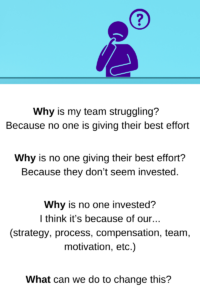Sales cycles are lasting longer, performance is down, there’s increased absenteeism – they seem unmotivated and unproductive. Maybe you’re starting to lose trust in them. The problem is – most sales leaders don’t have an accurate idea of why these problems started in the first place.
It is extremely important as a sales leader to know when you need to accept responsibility for your team. According to a study by the Harvard Business Review, CEOs who successfully turned a company around shared the same way of speaking. They took the blame for their team’s problems, using the words “I” and “we” but also passed the credit to their team using words like “us” and “we.”
“We seek to blame rather than actually acknowledge and resolve,” says Sales Trainer and Consultant, Jeff Bajorek. “You hire the reps, they don’t perform, then you put them on a PIP. Rinse and repeat.”
“It’s easy to become cynical, especially if you’ve been burned a few times in a row. But you’re the leader. You’re the one responsible for breaking this cycle.”
So, how do you break the negative sales cycle and get your team to thrive?
Jeff suggests you start by asking these questions:
- Are you hiring the right people?
- Are you giving them what they need?
- Do they clearly understand what you need from them?
- Do you clearly understand what you need from them?
- Are you holding them accountable to what you mutually agreed to as objectives and activities?
- Are you creating an environment for success or just a treadmill of paperwork and HR involvement?
It is important to note here that a Performance Improvement Plan, or PIP, should be used as a tool to help employees with performance deficiencies the opportunity to succeed. With this comes a responsibility to help your employee improve – not as a way to express any of your frustrations as a leader or start the termination process.
“Ultimately a PIP is a contract between a manager and an employee that requires additional resources to execute,” says Sales and Marketing leader, Chris Ruiz. “If it’s going to take coaching, check-ins, dashboards, resources, and whatever else to turn around a rep’s performance – you have to stop and ask, why weren’t these things there in the first place.”
As a sales leader, you must be aware and observe what is really happening with your sales team, rather than making assumptions or being biased about what you think may be happening. Holding 1-on-1s and keeping open lines of communication can be critical for your employees’ success. They should feel comfortable going to you with any issues they may be having.
Especially over the past two years, where people have been dealing with some incredibly hard times and mental health issues are at an all-time high. You may find their recent results have nothing to do with work, and through this, find another way to support them that can help boost their morale or performance.
Why Is My Sales Team Struggling?
According to Gartner, an employee perceives value by working in an organization across five attributes: Opportunity, People, Organization, Work, and Rewards. Your role as a sales leader means controlling these elements.
- Ensure development opportunities exist
- Fill open positions from their existing talent pool
- Improve manager quality & coaching
- Help promote work-life balance
- Build a pay-for-performance culture
If your sales team is struggling, you can use a “Why timeline” to help you identify the events that tell how or why these problems are occurring.
You start with the most basic issue your team is having, be truthful with yourself, and answer the “WHY statements” until you come to a better understanding or conclusion of the issue.
From there, you can more accurately determine the proper solutions for your sales team.
There might be more than one cause, but at least this can help you get the conversation started internally. As a sales leader, you have a direct influence on all of these elements.

Research shows there aren’t many sales professionals out there who are intrinsically motivated. Meaning, they aren’t in sales because they simply enjoy selling which is perceived as “interesting and meaningful for its own sake.”
The biggest killers of intrinsic motivators?
- Feeling threatened
- Being watched & Micromanaged
- Forced to always work under very strict deadlines
- Being ordered around
- Made to compete against other people
“Decades of creating the wrong sales environments has conditioned an entire industry focused on “performance” to actually underperform,” says Sales Mental Health Expert and Advocate Jeff Riseley. Figuring out to motivate your sales team is half the battle.
Salespeople who are extrinsically motivated, sell because of what they will “get” like the promotions, commission checks, freedom, and vacations. Research shows that teams who only focus on this type of intrinsic motivation experience a significant decline in:
-
- quality of performance
- being creative in the role
- continued learning through professional development
Jeff suggests focusing on intrinsic motivators and creating a safe environment and culture where your team feels appreciated and trusted. To help do this, you can provide your sales team with more autonomy over day-to-day tasks and processes.
Some samples can include more control over:
- taking time off
- help setting metrics and goals
- ideas and creation around email templates or content
- creativity around demo decks or other materials
We need to work in a safe, pleasant, and comfortable environment where there is room for growth and discussion. If you aren’t creating a better workspace for your employees, they will continue to struggle until they move on.
Are You Creating a Thriving Culture?
Your sales culture is one of the most important aspects that drive a selling organization. It drives buy-in, professional development, and overall team dynamics. It is also the framework for which strategy and processes are created and improved.
“The best morale exists when you never hear the word mentioned. When you hear a lot of talk about it, it’s usually lousy.”
Research at PwC concluded that while “87% of directors say inappropriate tone at the top leads to problems with corporate culture, 79% also point to the tone set by middle management.”
This shows that placing too much attention on short-term results, misguided compensation plans, and poor communication are the most common causes of stress on your cultural infrastructure.
Leaders can shape their definition of a healthy, productive culture with a two-step process.
The first step is to hold discussions at the executive level to determine and develop a cultural identity that agrees with the mission, vision, values, and long-term goals of the organization.
All company leaders should reach a consensus before moving forward.

The next step is to survey your team members to gain a better understanding of what constitutes a supportive culture. In these steps, the goal is to explore the best options for improvement, listen to feedback, and make an actionable plan that can be easily communicated. At the end of the day, it is the responsibility of the sales leader to set the tone for the culture.
“Culture can be a company’s best friend, but when volatility in the business environment requires change, culture can be the biggest obstacle,” says President of Gray’s Culture Mapping Technique, a roadmap for assessing and transforming your sales culture. Experts note that while the intended culture may be clearly stated on paper, the plan for sustainment often lacks that same structure.
They suggest leaders should consider drafting a sustainment plan in three parts:
Recognize Success: Instead of catching them doing something wrong, catch them doing things right. Look at how individual behaviors influence the team and their ability to achieve your desired outcome. Make them feel valued and appreciated in a setting where the focus is always on the individual and their personal quota. While there are many types of recognition, it’s important that a comprehensive recognition program for employees includes:
- day-to-day work accomplishments
- extra efforts, both small and large
- service anniversary (or career celebration) awards
- company events that celebrate shared success
Measure Outcomes: To be able to improve, you first need to measure. Be sure you are measuring the appropriate outcomes, activities, and results consistently, and along the same curve. Everyone on your sales team is their own unique individual, it is your role as a sales leader to make sure they all have the same opportunity to be successful.
- Use S.M.A.R.T (specific, measurable, attainable, relevant, and timely) goals and be sure to stay up-to-date on all industry standards, benchmarks, metrics, and data.
- Check to see whether you have tools and people who make the job easier and more efficient, or if you have tools and people who inhibit people from doing their jobs well.
- Don’t be a surveillance system in terms of output – set the expectations, measure the outcomes, and set milestone meetings to review.
How many leaders are so dependent on their CRM to manage versus actually leading and motivating their sales hires?” Senior sales leader Bill Barnhart continues, “It is important not to see your CRM has something that has all of the magic answers. ”
Too many times we see a CRM platform as the “be all/ end all” to a point that the leaders, as well as the C level executives who sometimes act like it’s a living being.” When technology is used properly, it makes your sales reps’ jobs easier, as well as yours, and can provide more meaningful measurements to success.
Hire (and fire) Accordingly: Hiring practices must be congruent with your intended culture. You can’t claim one thing and then hire a completely different way. The best way to spot soft skills is to bring multiple perspectives to the interview process.
A diverse range of personality types and backgrounds on a hiring panel will reduce the risk of confirmation and similarity biases. Before interviewing, make sure your team is on the same page for what a “good” candidate looks like.
Take a look at your current team. Who are the great team players? Why? What makes them great? Note the specific activities that create the best sales rep and the skills that help them create a better work environment and make sure your internal hiring team is on the same page when looking for these skills in an interview scenario.
- A great sales rep, great for company culture – This is a win-win, best-case scenario for you and your employee.
- A great sales rep, but a bad fit for the company- This type of sales rep might seem like a win since they are able to bring in sales, but their toxic behavior can quickly destroy a team.
- A bad sales rep but a great team player – This one is simply on a case-by-case basis. Maybe they don’t belong in sales, but if they are a great team player, perhaps there is a different role for them. Firing a sales rep is never easy, but you’re not doing anyone a favor by keeping them around if they just don’t belong in your organization.
Reflect and learn from good hires and bad hires. Assess the reasoning behind the situation and talk about it with your hiring team. Why did this candidate fail? What signs did we miss? Make a plan for putting a higher emphasis on those skills or behaviors you missed in future interviews.
Are You Improving Their Soft Skills?
According to a study from the RainMaker Group, “good sales managers select, hire, onboard, and coach salespeople who share a balance of certain hard-coded and soft-coded mindsets.”
Hard-coded skills represent a person’s beliefs, education, background, and technical skills that are shaped over the years through personal life experiences and circumstances. These skills are more job-specific which makes them easier to test, track, and monitor, like their writing skills or ability to set and meet goals.
“88% of sales professionals actively work on improving their soft skills. Those working on their soft skills are 11% more likely to achieve their regular sales targets.”
– The State of Sales Report 2020-2021
Soft coded skills consist of how they manage relationships, their communication skills, critical thinking patterns, or how they work in a team setting. These skills can be improved or reshaped into improvement by new patterns. Employees with strong soft skills contribute more to positive work environments, create better team relationships with colleagues, and are normally better representatives of the team and company they work with.
7 Sales Soft Skills Every Salesperson Needs:
- Empathy
- Emotional Intelligence
- Active Listening
- Growth Mindset
- Adaptability
- Communication
Working with your sales team to improve their soft skills can help your team increase their sales, improve customer service, retain employees longer, and help employees take more control of their personal development. The key is to practice these skills while performing their routine tasks, this way, you aren’t giving them more work, you’re just helping them shift their mindset.
The only way to improve these skills is through processes and feedback. You have to take your team into consideration and decide the best way to coach or mentor your team through a set of practices.
- Introduce a new skill on a timely basis and provide tangible examples that reps can model, including tone, body language, and behaviors.
- Practice role-playing certain sales scenarios.
- Enable your reps to record or hear themselves delivering a message and mentor them through self-reflection and constructive feedback.
Are They Properly Compensated?
Compensation packages (obviously) have a huge impact on an employee’s level of engagement, job satisfaction, retention, prospective recruitment, and overall work productivity. In an industry where high turnover and high pressure are so prevalent, one way to help decrease turnover is to create a detailed formula for determining base salary, commission, bonuses, and benefits.
Unfortunately, just like a good compensation plan will motivate employees, a bad one could cost your organization more than you think. The US Department of Labor reported that nearly 4 million professionals quit their jobs in June 2021. Research from Gartner estimates that each departing employee costs almost $19K. Although not specific to sales, it should provide a quick look into the direct impact on your organization.
“Hypothetically, if you have a sales force of 100 sellers with an 18% turnover, that’s a $335k consequence.”
Hubspot
The formula for determining a sales compensation plan varies by business, structure, size, resources, and goals. Some companies will provide a higher base salary while others provide an opportunity to earn higher commissions.
No matter the structure, plans should be easily understood and communicated to the entire team so everyone knows what they need to accomplish to reach their next respective goal.
Hubspot advises that sales leaders differentiate responsibilities and pay between junior, mid-level, and senior roles in order to communicate more opportunities for advancement. There should be a compensation plan for every member of the sales team based on their role, experience, length of the sales cycle, and the type of deals they engage in.
If you need more guidance, you can think about the industry standard, which is 60:40 — meaning 60% fixed to 40% variable. A less aggressive ratio (think 70:30 or 75:25) is common when reps are required to teach the prospect because they’re most likely selling a highly complex or technical product.
By knowing how much you’ll pay each rep depending on their experience and performance, you can create budgets that better align with your company’s financial standing. That way, you know how much of the company’s earnings will be allotted for your sales reps’ compensation. This will allow you to better prepare if the team underperforms one quarter.
Are Your Clients Dissatisfied?
Client dissatisfaction often comes from shortfalls within your product or service or not meeting a certain level of expectations from a cost or value standpoint. Bad reviews, poor lead generation and conversion, loss of customers, and a decrease in sales can all result from client dissatisfaction.
“Your sales team may not be directly involved in creating and distributing your products, but the process can still have a direct impact on your sales.”
Entrepreneur
That’s why high-performing organizations have this in common – they strictly monitor dissatisfaction and why it’s happening.
It can take a serious toll on your sales team if the product they sold is bringing in chargebacks or cancellations. If you are facing this issue as a sales leader it is important to teach your reps how to properly deal with customer complaints when the product presents flaws or bugs. Teach your sales reps to acknowledge the problem and be honest with customers.
Just as your sales reps must understand the facts of the issues, they must be able to offer a solution that can help satisfy your clients. Your company must work to make the necessary changes or improvements or you will see an immediate increase in turnover and poor morale.
Invest in product development, as well as your customer service efforts, and you’ll likely find that your team performance improves.
Do They Have Insufficient Leads?
Bigger sales goals come from a combination of talented sales professionals and supportive businesses. When leaders invest in the right tools and technologies to gain higher-quality leads, it’s easier for team members to do their jobs and close more deals.
more leads = more paying customers = business gains cash flow it needs to grow
When your team is struggling, it’s a lot easier to sit there and point fingers at everything they could be doing to get better results. As a sales leader, you need to determine what you can do to give your team the best chance at success.
- Are you selling to your ideal client profile?
- Are you speaking to the right pain point and solution?
- Where have your best leads come from historically?
- Where do your best leads come from now?
- Are you spending enough time prospecting?
- Is your team large enough to meet your goals?
- Are you using the right prospecting tools?
- How long is your sales cycle?
- What number of new leads should each sales rep work on per week?
Without solid answers to these important questions, your sales team will continue to struggle. An outsourced sales partner can work with your team to generate a strong sales pipeline while giving your team more time to focus on closing deals.








